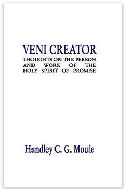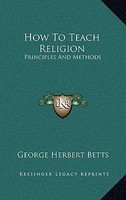HOW TO TEACH RELIGION
Principles and Methods
by GEORGE HERBERT BETTS
Sunday School Lesson, Sunday School Lesson for kids
How to Teach Religion is a book on how to teach religion for Christian educations (Sunday School Lesson, Sunday School Lesson for kids).
THE ABINGDON PRESS
NEW YORK CINCINNATI
1926

Moule Veni Creati is an old, well known work in studies in the Holy Spirit by Bishop (Anglican) H.G.C. Moule. It has 12 chapters. It is a deep treatment of the Holy Spirit. Although Moule was Anglican, his writings are well written and good.
Downloads:
theWord: Moule Veni Creati
MySword: Moule Veni Creati
ESword:Moule Veni Creati
Adobe Acrobat PDF: Moule Veni Creati
In this work, educator Betts (Methodist Episcopal) explains how a person teaches religion. He begins with the person of the teacher, then the great objective, a fourfold foundation (right aims, material, organization, and presentation), religious knowledge, religious attitude, connecting instruction with life and conduct, the subject matter of religious education, organization of the material, the technique, making truth vivid, types of teaching, and methods, etc. His work is directed at helping the teacher to be a better teacher for the glory of God.
CONTENTS
I. THE TEACHER HIMSELF 13
Importance of the teacher–Three types of teachers–The personal factor in teaching religion–Developing the power of personality–The cultivatable factors in personality–A scale for determining personality–The teacher’s mastery of subject-matter–Methods of growth–Fields of mastery demanded–Service and rewards–Problems and questions.
II. THE GREAT OBJECTIVE 30
Two great objectives in teaching–Making sure of the greater objective–Teaching children _versus_ teaching subject-matter–Subject-matter as a means instead of an end–Success in instruction to be measured in terms of modified life, not of material covered–The goal of a constantly developing Christian character and experience–Problems for discussion.
III. THE FOURFOLD FOUNDATION 42
What the fourfold foundation consists of: (1) right aims, (2) right materials to reach these aims, (3) right organization of this material for instruction, (4) right presentation in instruction–The aim of teaching religion is (1) fruitful knowledge, (2) right religious attitudes and growing consciousness of God, (3) power and will to live righteously–Selecting subject-matter to meet these ends–Principles of organization of material–The problem of effective presentation–Questions for discussion.
IV. RELIGIOUS KNOWLEDGE OF MOST WORTH 58
Not all religious knowledge of equal value–What determines value of knowledge–Kind of knowledge needed by child–Developing the child’s idea of God–Harm from wrong concepts of God–Giving the child the right concept of religion–The qualities by which religion should be defined to the child–The child’s knowledge of the Bible; of the church; of religious forms of expression–Problems and questions.
V. RELIGIOUS ATTITUDES TO BE CULTIVATED 76
The meaning of religious attitudes–These attitudes lie at the basis of both motives and character–Importance of the pupil’s attitudes toward the church school and class–Enjoyment of the lesson hour and the growth of loyalty–The sense of mastery necessary to mental and spiritual growth–The grounding of a continuous interest in the Bible and religion–Growth in spiritual warmth and responsiveness–The cultivation of ideals–The training of fine appreciations–Worthy loyalties and devotions–Clearness of God-consciousness–Questions and problems.
VI. CONNECTING RELIGIOUS INSTRUCTION WITH LIFE AND CONDUCT 91
Religious instruction must carry across to life and conduct–Hence necessity of finding practical outlet in expression for feelings, ideals, emotions and attitudes resulting from instruction–The setting up of certain religious habits–Expression in connection with the life of the church–Expression in the home life–Expression in the community and public school life–Expression in worship and the devotional life–Problems for discussion.
VII. THE SUBJECT MATTER OF RELIGIOUS EDUCATION 109
The Bible the great source-book of religious material–Yet much material other than biblical required–Principles for the selection of material from the Bible–Biblical material for early childhood; for later childhood; for adolescence–Story material and its sources–Materials from nature–Materials from history and biography–Picture material for religious teaching–Religious music for children–Questions and problems.
VIII. THE ORGANIZATION OF MATERIAL 129
Four different types of organization–Organization applied (1) to the curriculum as a whole, (2) to individual lessons–Haphazard organization–Logical organization–Chronological organization–Psychological organization–Three types of curriculum organization: (1) Uniform lessons, (2) Graded lessons, (3) text books of religion–Organizing daily lesson material–Typical lesson plans–Problems for discussion.
IX. THE TECHNIQUE OF TEACHING 148
Teaching that sticks–Attention the key–Types of appeal to attention–The control of interest–Interest and action–Variety and change as related to interest–Social contagion of interest–The prevention of distractions–The control of conduct–Danger points in instruction–Establishing and maintaining standards–Questions and problems.
X. MAKING TRUTH VIVID 165
Vividness of impression necessary to lasting value–The _whole_ mind involved in religion–Learning to think in religion–Protecting children against intellectual difficulties–The appeal of religion to the imagination–Guiding principles for the religious imagination–The use of the memory in religion–Laws of memory–How to memorize–Problems for discussion.
XI. TYPES OF TEACHING 183
The several types of lessons for religious instruction–The informational lesson–The use of the inductive lesson–The deductive lesson in religion–The application of drill to religious teaching–The lesson in appreciation–Conducting the review lesson–How to make the lesson assignment–Questions and problems.
XII. METHODS USED IN THE RECITATION 201
Methods of procedure for the lesson hour–The use of the topical method–Place and dangers of the lecture method–Securing participation from the class–The question method–Principles of good questioning–The treatment of answers–The story method–Guiding principles in story teaching–The teaching method of Jesus–Jesus the embodiment of all scientific pedagogy–Questions and problems.
AUTHOR’S PREFACE
Children can be brought to a religious character and experience through right nurture and training in religion. This is the fundamental assumption on which the present volume rests, and it makes the religious education of children the most strategic opportunity and greatest responsibility of the church, standing out above all other obligations whatever.
Further, the successful teaching of religion is based on the same laws that apply to other forms of teaching; hence teachers in church schools need and have a right to all the help that a scientific pedagogy permeated by an evangelistic spirit can give them. They also have the obligation to avail themselves of this help for the meeting of their great task.
This book undertakes to deal in a concrete and practical way with the underlying principles of religious instruction. The plan of the text is simple. First comes the part _the teacher_ must play in training the child in religion. Then the spiritual changes and growth to be effected in _the child_ are set forth as the chief objective of instruction. Next is a statement of the _great aims,_ or goals, to be striven for in the child’s expanding religious experience. These goals are: (1) fruitful _religious knowledge_; (2) right _religious attitudes–interests, ideals, feelings, loyalties_; (3) the _application of this knowledge and these attitudes to daily life and conduct_.
Following the discussion of aims is the question of just _what subject matter_ to choose in order to accomplish these ends, and _how best to organize_ the chosen material for instruction. And finally, _how most effectively to present_ the subject matter selected to make it serve its purpose in stimulating and guiding the spiritual growth and development of children.
The volume is intended as a textbook for teacher-training classes, students of religious education, and for private study by church-school teachers. It is also hoped that ministers may find some help in its pages toward meeting their educational problems.
Northwestern University,
Evanston, Illinois.
Donate a Cup of Coffee to Me

It takes a lot of work, energy, time, and money to create, maintain, protect, and make new works constantly. While you may benefit from all my work only spending 5 minutes a week, it takes me hours and hours, and hackers attacking, many more. Just $5 dollars goes a long way to cover my financial burden of managing this site.
Click to donate any amount.
MySwordmodules is a website dedicate to the MySword Bible Program for Androird devices. We host MySword Modules.

A carpenter making his own tools is an explanation of why I, Pastor-Missionary David Cox, write my own material. I like the idea of producing the material that we use in our ministry and also for evangelism.
Read the short article: A carpenter making his own tools.


